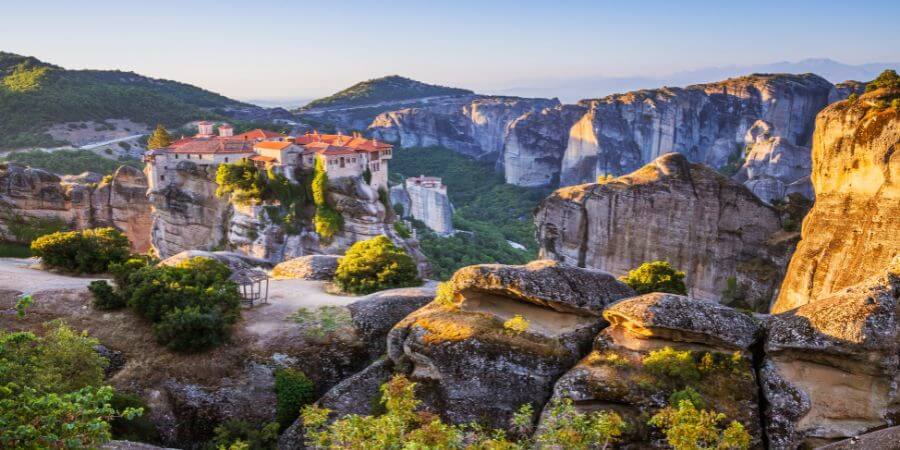In the heart of mainland Greece, where the Pindus Mountains meet the Thessalian plain, lies an awe-inspiring geological wonder and a testament to human perseverance – Meteora. This enchanting UNESCO World Heritage site is famous for its towering rock pillars and the ancient monasteries that seem to defy gravity as they cling to the cliffs. Meteora, which translates to “suspended in the air,” is not only a unique destination for travelers but also a spiritual sanctuary with a rich history and breathtaking natural beauty.

1. Meteora: Geological Marvel
The formation of Meteora’s distinctive rock pinnacles is a story that spans millions of years. These colossal rocks, composed primarily of sandstone and conglomerate, are the result of river and weather erosion.
The geological transformation began about 60 million years ago when the area was submerged beneath the sea and layers of sediment were deposited. Over eons, the landscape changed, and tectonic movements lifted these sedimentary layers into the air.
Meteora’s striking pillars reach heights of up to 400 meters (1,300 feet), providing a dramatic contrast to the surrounding landscape. The view of these towering monoliths is nothing short of breathtaking, whether seen from the valley below or experienced up close while exploring the monasteries.
Meteora: Spiritual Oasis
The history of Meteora is deeply intertwined with spirituality. The monastic community that inhabits this remote and mystical place dates back to the 9th century, with the first hermit monks seeking solitude and spiritual connection among the rocks.
It wasn’t until the 14th century that the monasteries as we know them today began to take shape. At its zenith, there were 24 monasteries, each perched on precarious cliffs, accessible only by ladders, nets, or baskets winched up the rock faces.
Six monasteries remain active today, and they continue to be centers of Orthodox Christian faith and spirituality. The monastic traditions and way of life have been preserved throughout the centuries, making Meteora a living testament to the power of faith and resilience.
The monasteries also house remarkable collections of religious art, manuscripts, and artifacts, many of which provide a glimpse into the region’s history and the development of Orthodox Christianity in Greece.
Meteora: Journeying to the Clouds
Visiting is an adventure in itself. The most common way to reach the monasteries is by climbing a series of steep stairs and walking along narrow paths that lead to the top. The effort is rewarded with spectacular views of the surrounding valley and the pillars that make this place unique.
Each of the six monasteries has its own character and history, but some of the most renowned are the Holy Monastery of Varlaam, the Great Meteoron Monastery, and the Holy Trinity Monastery, which gained international recognition after being featured in the James Bond film “For Your Eyes Only.”
Photography enthusiasts will find it to be a paradise, offering countless opportunities to capture the breathtaking landscapes and architectural marvels, especially during sunrise and sunset when the warm, golden light bathes the monasteries in a surreal glow.

The FREE Packing Guide for All-Inclusive Trips
Download our fillable and printable packing list + tips + more!
Conclusion
Meteora is more than just a tourist destination; it’s a place where nature, history, and spirituality intertwine in a mesmerizing tapestry. The surreal beauty of the towering rock formations and the ancient monasteries perched atop them is a sight to behold, leaving an indelible impression on all who visit.
Whether you seek spiritual enlightenment, natural wonders, or a journey into Greece’s rich past, Meteora offers it all. It’s a place where ancient traditions have stood the test of time, where nature’s grandeur stirs the soul, and where human determination reaches for the heavens. To experience Meteora is to be transported to a realm suspended between the earth and the divine, a place that truly lives up to its name.

Frequently Asked Questions (FAQs)
What is Meteora, Greece?
- Meteora is a UNESCO World Heritage site located in central Greece, known for its unique rock formations and monasteries perched on top of these towering cliffs.
How did Meteora get its name?
- The name “Meteora” translates to “suspended in the air” or “in the heavens.” It aptly describes the monasteries’ dramatic locations atop the rock pillars.
How were the monasteries of Meteora built?
- The monasteries of Meteora were built by monks and hermits who sought seclusion and spiritual isolation. They used a combination of ladders, ropes, and pulleys to transport materials and people to the cliffside locations.
How many monasteries are there in Meteora today?
- There are six active monasteries in Meteora: The Great Meteoron, Varlaam, Roussanou, Holy Trinity, St. Stephen, and St. Nicholas Anapafsas.
What is the history of Meteora’s monasteries?
- Monastic life in Meteora dates back to the 9th century, with the construction of monasteries beginning in the 14th century. The monasteries played a crucial role in preserving Greek culture and religion during various historical periods.
How can I visit Meteora?
- Meteora is accessible by road and is approximately a 4-hour drive from Athens. You can also reach it by train or bus from major Greek cities. Once there, you can explore the monasteries by foot or car.
What is the best time to visit Meteora?
- The best time to visit Meteora is during the spring and autumn when the weather is pleasant, and the natural beauty is at its peak. Summers can be hot, and winters can be cold with some monasteries closed during the off-season.
Do I need to pay an entrance fee to visit the monasteries?
- Yes, there is an entrance fee for each monastery you visit. The fees help with the maintenance and preservation of these historic sites.
Are there hiking trails in Meteora?
- Yes, there are several hiking trails that offer breathtaking views of Meteora’s rock formations and monasteries. These trails cater to a range of hiking levels, from easy to more challenging routes.
Is photography allowed in the monasteries?
- Photography is generally allowed in the outdoor areas of the monasteries. However, there are restrictions on photography inside the monasteries, particularly during religious ceremonies.
Are there accommodations near Meteora?
- Yes, there are many hotels and guesthouses in the nearby town of Kalambaka, which serves as the base for most visitors to Meteora.
What are some nearby attractions to visit along with Meteora?
- Nearby attractions include the picturesque village of Kastraki, the Pindus National Park, and the stunning Pindus Mountains, offering opportunities for outdoor activities like hiking and rock climbing.
Visiting Meteora is a truly unique experience, where history, spirituality, and natural beauty combine to create an unforgettable journey. These FAQs should help you plan your trip and make the most of your visit to this remarkable destination.
Recommended for You
Packing for travel like a pro can be both exciting...
As the days grow longer and the warmth of the...
Embarking on a journey, whether for business or leisure, calls...
In the fast-paced world we live in, the allure of...
Author

Cotripia is your gateway to elevated travel. We serve as your portal to the world of stylish travel, exquisite beauty products, luggage, and all the vital travel essentials. Furthermore, we provide an array of valuable resources, including expertly crafted packing guides, meticulous checklists, insider tips, enlightening ebooks, and much more.
View all posts






